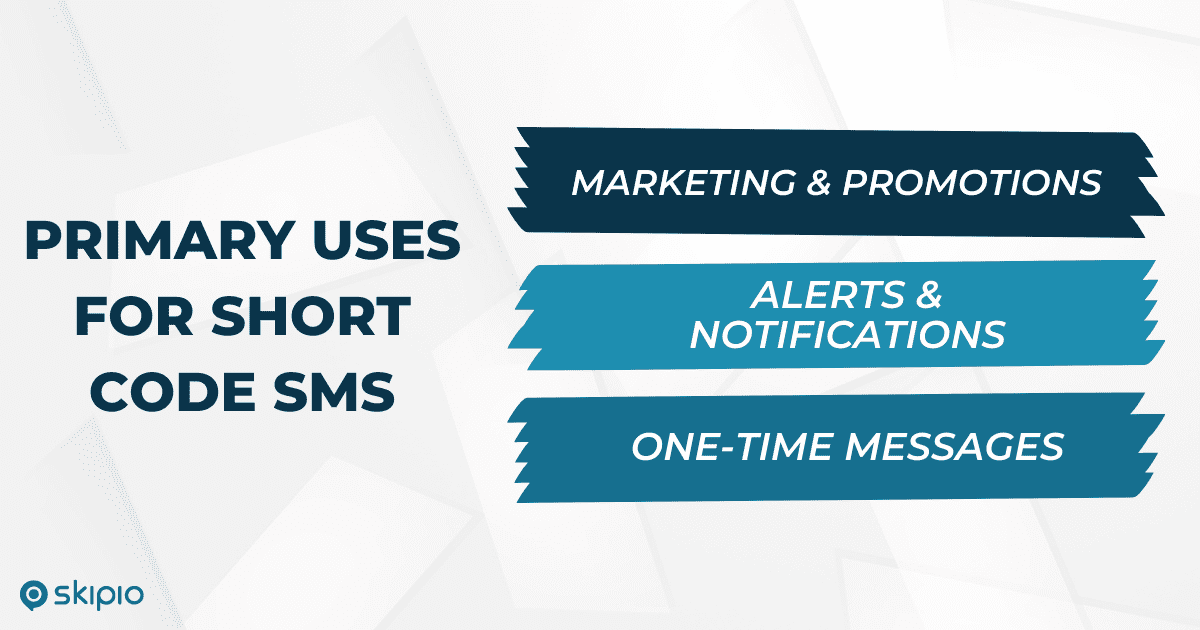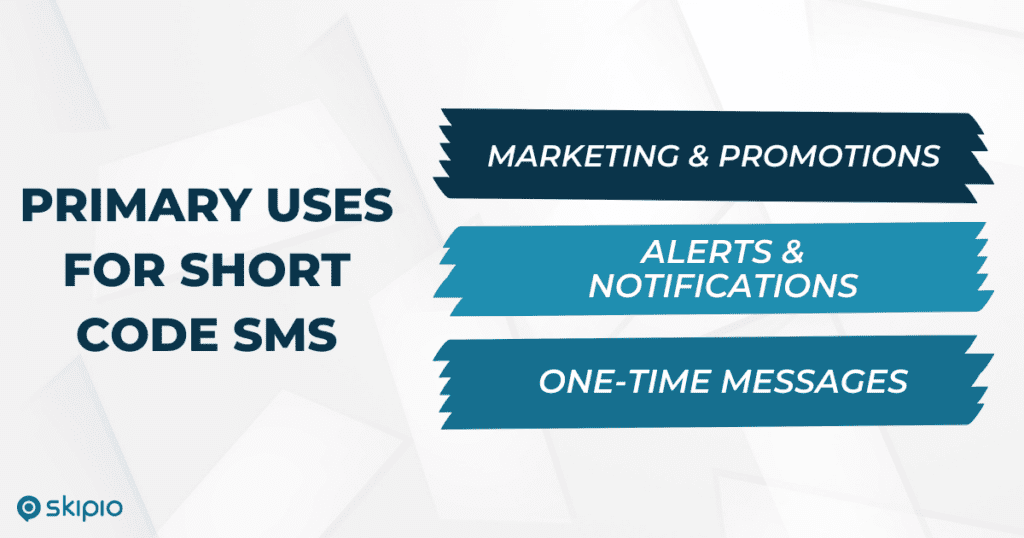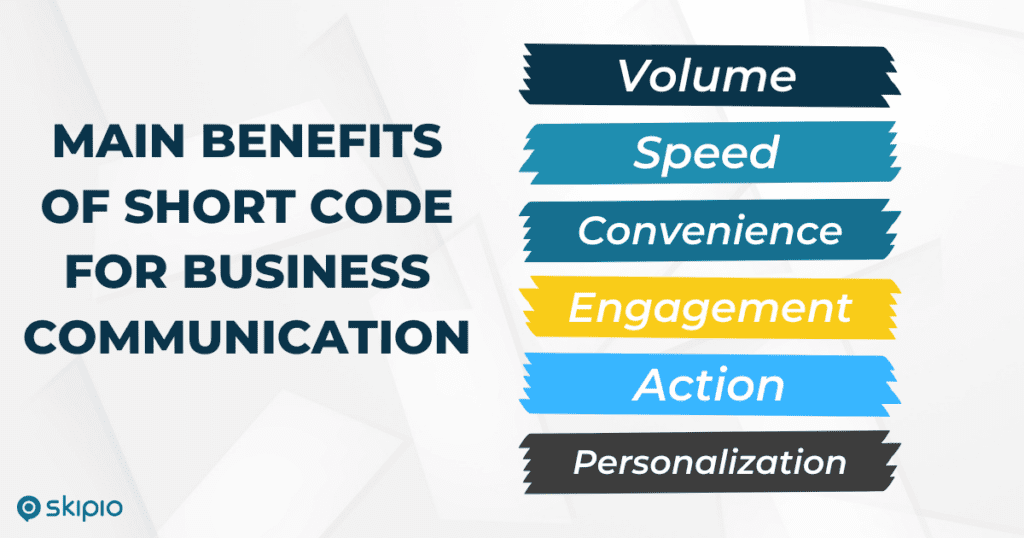
Skipio’s priority has always been providing businesses and teams with text messaging tools that encourage engagement and action. So far our focus has been long code numbers for conversational texting. Today we further expand your reach with the launch of short code numbers for mass text messaging.
Make no mistake: Conversational messaging remains vital to Skipio, just as it does to small and large businesses. Over the last five years we’ve seen first-hand the positive impact texting has on conversions.
Bulk SMS text messaging through short code is yet another way businesses can reach more customers and increase revenue.
Begin the application process for getting a short code or keep reading to learn why businesses choose short code and how they use it engage their target audiences.
What is an SMS short code
Short codes are 5- or 6-digit numbers used primarily for one-way communication. In many cases businesses use short code to deliver targeted marketing promotions to large groups of contacts. If you’ve heard the term “text marketing,” it was most likely in relation to short code mass text messaging.
To receive messages from a company’s short code number, people must opt in. This generally occurs by checking a box that you consent to receiving text message communications from a brand or by texting a keyword to the short code number.
Short code enables businesses to send text messages at a significantly higher volume than 10-digit long code numbers.
Short code vs. long code: What’s the difference?
Sending messages with both short code and long code numbers can get people to take action.
Short code is great for quick one-way communication where you don’t require conversational responses from the recipients. When you have information to share with a large group of people — we’re talking hundreds if not thousands and thousands — you definitely want to use short code. Sending is completely automated with short code and it doesn’t require intense monitoring as you won’t be having conversations.
Long code is great for 1-on-1 conversations and individual engagement with customers. If you want to ask questions that aren’t just yes/no, provide customer support, or otherwise talk personally with individuals, you need 10-digit numbers for your team. Automation is still a huge part of using long code for business texting, but the human element needs to be present.
Read an in-depth comparison of these business texting options.
What are short codes used for
There are three primary use cases for short codes.
1) Marketing and promotions
2) Alerts and notifications
3) One-time messages

Both B2C and B2B businesses use short codes specifically to:
– Share marketing promotions, special offers, and sales
– Conduct simple surveys and gather feedback
– Send confirmations and reminders for orders, reservations, or appointments
– Make announcements for groups or events
– Deliver shipping updates and order changes
– Enable two-factor authentication
Short code numbers are country-specific and cannot be used internationally. If you conduct business in multiple countries, you must acquire numbers specific to each location and familiarize yourself with the rules and regulations in those places.
Different types of SMS short codes
There are a few types of short code numbers that you need to be aware of before you choose to apply for one.
Random short codes vs. vanity short codes
Random short code numbers are just that: random. You will be randomly assigned a 5- or 6-digit number. This is the more cost-effective choice.
If you want to choose exactly what your short code number will be, you need a vanity short code. You can choose whether you get a 5- or 6-digit number. Businesses often opt for a vanity number if they want something that will be more memorable or recognizable. However, vanity numbers are more expensive.
Shared vs. dedicated short codes
Previously, businesses had the option between a shared number or a dedicated number.
A shared short code number meant your favorite coffee shop and the shoe store at the mall might text you from the same 5-digit number. You’d be part of totally separate lists created by each business.
Shared numbers were less expensive for all involved, hence their popularity. However, as of 2021, carriers are in the process of banning shared short codes. Any business using a shared short code number will need to transition to a dedicated number (if they haven’t already).
Now all businesses, brands, or organizations must use their own designated number that no other business will send messages from.
SMS short code volume and messaging speeds
Short code does allow messages to send faster than long code. The exact speed varies based on your texting provider, but it’s normal with short code to be able to send thousands of messages per minute. In comparison, a 10-digit number can send 60 messages per minute.
However, it’s not the speed that matters when comparing short and long code. Faster sending won’t do you any good if you aren’t sending the right type of messages.
Short code’s main benefit is the volume of messages you can send. If you want to do bulk sending — pushing out information to thousands and thousands of people — you need short code.
Keep in mind that neither short code or long code is inherently better because of the volume limits. Each helps you accomplish different marketing and sales goals. So in some cases you’ll want short code; in others, you’ll see more success with long code.

How do I get an SMS short code?
All short code numbers in the United States are found and leased through the Short Code Registry and administered through the CTIA’s Common Short Code program. In other words, no one owns their short code number.
To simplify the process of finding, leasing, and activating a short code, businesses find it useful to work with text messaging providers like Skipio. Our team guides you through the whole process of applying for and obtaining a short code number and getting it ready to send messages.
This includes submitting an application to the various wireless carriers in order to activate your short code number for sending. Otherwise you have a number that doesn’t do anything!
In this application you will:
– State your intended use case
– State the number of messages you intend to send to subscribers each month
– Provide examples of messages you want to send
– Prove that you honor opt outs, including examples
– Provide links to your terms of service
– Show the opt-in process, including example messages and images of opt-in locations
If for some reason your application is not approved by carriers, we work with you to ensure your next application is successful.
Finally, after everything is approved and connected, you’ll be able to log in to Skipio to start sending messages from your short code number.



